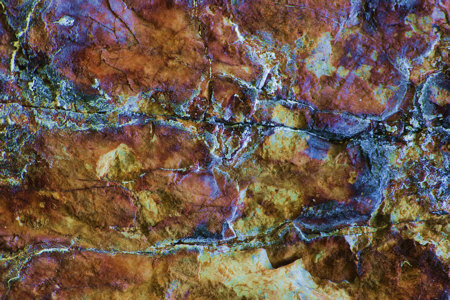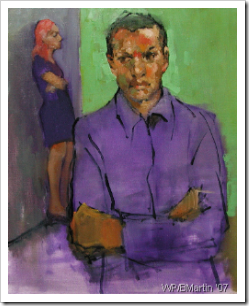Posted by Doug Plummer on March 6th, 2007
I was planning on posting this anyway, apropos of leaving on vacation with my wife, Robin, today. Then I saw Steve Durbin’s entry, and realized it would be the perfect follow-up. It’s a piece she wrote for my blog last year, but I think only 30 people saw it at the time. Her advice deserves a wider audience.
Advice to photographers’ significant others:
- When on a shoot or on the road, always bring food, water, and a book. If the light becomes “perfect” (usually early or late in the day, or if it’s overcast in just the right way), your photog will be captivated by it. Do insist on your right to go to the bathroom, be dropped at the hotel before the light comes in, or have your basic needs taken care of.
- Don’t take it personally when he says, “The light is beautiful on you.” You could be a rock, or a stump, or a wall. But he probably loves you anyway.
- Don’t take it personally when you become the “foreground element”. It’s not about you. You’re just the one that’s there.
- Do take it personally, in the best way, if you become the object of many studies. Photographers connect with the world through their cameras. It is another way of being known.
- You don’t have to like all of the work, if you like the photographer. Doug has one body of work that is too visually complex for my brain to process. None of this work is in the living room. If your person needs you to love every picture, send him to therapy. If you think you need to love every picture, go yourself.
- Get used to schedule changes. Your photog might find out on Tuesday that he’s going to Ireland for two weeks on Thursday. Have friends to fill in the gap. Accommodations I figured out included putting in a watering system for the garden, hiring people to do some of his tasks, and letting myself be pissed about the changes, until I’m not.
- Keep in contact. In most places in the developed world, there are local cell phones for sale. Speak often. Email. Whine. Say endearments. Listen to whining. Support. Ask for support. It’s good glue. We talk almost every day. I especially like to bask in Doug’s excitement when he’s on a shoot and it’s going well. He does bliss well.
- It’s okay to demand that the geek speak stops, when you’ve run out of patience for it. Especially if they’re talking about digital workflows. It’s rude for people to speak in a language not shared by others.
- When he comes back into town with 4,000 images to process, make some dates to connect, but don’t expect that he’ll be fully there until the images are on a disc and sent away. Then you can have the coming-back fight and really connect.
- It’s OK to play the wife role, whatever your gender, on occasion. I do this at openings and print sales and during the big post-shoot image processing. Other times, be who you are, more than wife. Doug is the wife at my conferences and book signings and when I’m writing. It’s OK to be flexible. Don’t get caught up in the role. It’s not a full enough identity for anyone.
- If you’re traveling together, don’t think you have to be joined at the hip. Pursue your own interests, then meet later. Do ask your person to leave the camera in the room or in the bag for a meal or an evening. Suggesting that making contact with you might allow your photog to “get lucky” can help this occur. It works for me.
- If he’s been gone for a long time, and you’ve had the house to yourself, expect conflict on re-entry. It’s normal. It’s predictable. Just have it. He’s invading your space, after all.
- Dont worry about the “Bridges of Madison County” scenario. You know how he really is.
- A story: Several years ago, outside of Banff, after a full day of shooting, the light changed and Doug became enchanted. I was really hungry. After 45 minutes, I demanded to be driven into town for food. Reluctantly, Doug packed up his gear, and we drove to a 2nd-floor sushi bar. I was facing the window. The light was magical. We ordered anyway. Before the fish came, I saw a rainbow over Mount Rundle. I said, “Doug, get your gear and get out there.” He did. 20 minutes later he returned. Three minutes later, the second rainbow appeared, arcing over the other. “Get back out there, now!” The waiter didn’t know what was going on. He kept asking if everything was alright. He didn’t understand my explanation: “My husband is a photographer.”
Robin’s blog (on therapy issues, for other therapists–you think photographer’s use geekspeak?) is at Trauma & Attachment.
Posted by Bob Martin on March 1st, 2007
Artist at times have a choice between telling the honest to goodness truth or in-creditable lies. This painting (wp) is the truth as I experienced it. It is also a story that is not often featured in any media.

Posted by Steve Durbin on February 27th, 2007

Karl asked me last week: What am I trying to say with my Patina photographs of old paint on old cars? Within the context of what I had just been doing — starting to work with strong color and abstract patterns — I quite honestly answered that I didn’t know. But to work with the images, I had to retrieve them from a computer directory “Junkyard cars” that was paired with another one, both under the rubric “Patina-Altered Surfaces.” It wasn’t until browsing later that I was reminded of that second directory called “Rocks.”
more… »
Posted by Richard Rothstein on February 25th, 2007
img src=http://rjr10036.typepad.com/proceed_at_your_own_risk/images/mondrian.jpg alt=”” align=”middle” />
An admirer of my photography recently praised my clever ability to capture the spirit of the great Dutch painter Piet Mondrian in my work. I was quite taken aback by this and without diminishing the genius of Mondrian, I felt obliged to explain to my admirer that he was putting the proverbial cart before the horse. The only relationship I can claim to Mondrian is that our work benefits from the same model, the same muse.
In one sense, Mondrian did not create Broadway Boogie Woogie, rather the boogie woogie of Broadway inspired Mondrian. Mondrian recorded and interpreted with his brush what I record and interpret with my camera: a unique energy fueled by verticals, horizontals and colors that is the visual signature of Manhattan and it’s relentless boogie woogie.

As a young man off on his first world adventures I was stunned by the revelation that many of the great artists I admired did not invent their mysterious landscapes, colors and visual signatures of China, Japan, Tuscany and Provence. Rather they were brilliantly capturing the unique moods, colors, light and shapes that nature had already chosen to create. I remember gazing over the hills of Tuscany for the first time and thinking, “Oh! So that’s where Leonardo got that.” And I remember the day I realized the Van Gogh was “photographing” (through his unusual lens) the unique palette and landscapes of Provence.
more… »
Posted by Bob Martin on February 22nd, 2007
I’ve always had this interest in how I might be able to tell a story in my paintings, without having to layout every detail.

This painting is a “work in progress” and for me it’s about distance. The two figures have adopted the same stance and maybe for different reason. Because they appear to be in the same location/room, they are together. I will find out what they are about as I continue to paint. Figuring out the story is one of the most enjoyable parts of painting for me.
Posted by Doug Plummer on February 13th, 2007

A while ago I got “fan mail” from someone regarding my portfolio of “stick pictures,” a body of work that I make in dense, brushy environments. She wanted some insight into my process, and I thought it would be illustrative to share the exchange here.
“Often I find that pictures of this nature look cluttered and pinched, but yours I find to be exceptionally emotive and contemplative. I was wondering about your mental and emotional approach to shooting these images. Do you focus more on the mental, with respect to composition, or is it something that you feel more so than see?”
My response:
“Thanks for the note. The “stick pictures” is where I do my deep work as a photographer. It is internal, it is visceral, and the question of why that sort of landscape is so compelling to me is not the interesting one. I’m grateful that there is such a rich vein for me to mine and that it has stayed so compelling for so many years.
“Though I’m sure it would be hugely valuable, I don’t meditate, I don’t do yoga, and I don’t have a regular practice to center myself or otherwise quiet the inner voice in my head so that I can pay attention to the moment. I’m actually an anxious fidgeter much of the time, and I’m forgetful and absent minded. Working with the camera, in the landscape, is the closest I get to a meditation practice of any kind, and it probably occupies that role in my life. I do know that, in those complex brushy environments, I am able to let go of the conscious attention to composition and framing and the sense that “now I’m taking a picture.” The pictures find themselves, and I follow. That part of the brain that is a lot smarter than the part that consciously knows what is going on is taking the lead.
“I have, though, been working this way for a couple of decades. The technical part is fluid and unconscious. I also take a lot of bad pictures when I’m out there. A lot of the work is attending to the results of a given shoot, and ferreting out the one shot that exemplifies the coherence of the moment. My method is to post proof prints in a place where I will see them in my peripheral vision for awhile, like my kitchen. Over time I take down the ones that bore me, and I see what survives. It is the spawning salmon method of photography. Most of the roe get eaten. Only a select few grow to adulthood and see the world.”
The link to the portfolio is here. I’ve fixed the code that seemed to keep non-IE users from viewing the page.
Posted by Angela Ferreira on February 11th, 2007
Are quick drawings and paintings artworks or just studies? Are they value at all?
A lot of drawings of old masters have an immense value nowadays but looking at contemporary artists drawings, are they such important?
Why don’t contemporary artists exhibit mostly their drawings and experiments, just their final masterpieces?

Scrying – pencil and chalk, quick drawing on paper

Drawing from imagination, pencil on paper

Spiritual, Mixed media on paper







